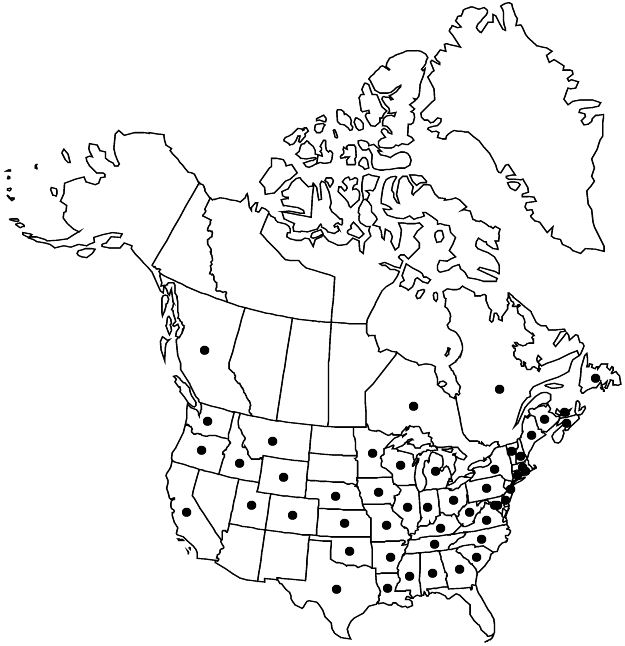Difference between revisions of "Rosa rubiginosa"
Mant. Pl. 2: 564. 1771.
FNA>Volume Importer |
FNA>Volume Importer |
||
| Line 29: | Line 29: | ||
|distribution=Europe;w Asia;n Africa;introduced widely worldwide. | |distribution=Europe;w Asia;n Africa;introduced widely worldwide. | ||
|discussion=<p>Varieties 2 (2 in the flora).</p><!-- | |discussion=<p>Varieties 2 (2 in the flora).</p><!-- | ||
| − | --><p>Rosa rubiginosa has been introduced throughout Canada and the United States except the desert southwest. Plants are compact, upright shrubs without rhizomes. Stems have stout, falcate infrastipular prickles mixed with internodal prickles, aciculi, and glandular setae. Leaflet blades are densely viscid-glandular with ripe apple scent and margins 2- or multi-serrate with stipitate glands.</p><!-- | + | --><p><i>Rosa rubiginosa</i> has been introduced throughout Canada and the United States except the desert southwest. Plants are compact, upright shrubs without rhizomes. Stems have stout, falcate infrastipular prickles mixed with internodal prickles, aciculi, and glandular setae. Leaflet blades are densely viscid-glandular with ripe apple scent and margins 2- or multi-serrate with stipitate glands.</p><!-- |
| − | --><p>Rosa eglanteria Linnaeus is a formally rejected name that pertains here.</p> | + | --><p><i>Rosa</i> eglanteria Linnaeus is a formally rejected name that pertains here.</p> |
|tables= | |tables= | ||
|references= | |references= | ||
| Line 66: | Line 66: | ||
|publication year=1771 | |publication year=1771 | ||
|special status=Introduced;Weedy | |special status=Introduced;Weedy | ||
| − | |source xml=https://jpend@bitbucket.org/aafc-mbb/fna-data-curation.git/src/ | + | |source xml=https://jpend@bitbucket.org/aafc-mbb/fna-data-curation.git/src/8f726806613d60c220dc4493de13607dd3150896/coarse_grained_fna_xml/V9/V9_133.xml |
|subfamily=Rosaceae subfam. Rosoideae | |subfamily=Rosaceae subfam. Rosoideae | ||
|tribe=Rosaceae tribe Roseae | |tribe=Rosaceae tribe Roseae | ||
Revision as of 18:14, 18 September 2019
Shrubs, erect; not rhizomatous. Stems 10–30 dm; distal branches arching, bark dark brownish red; infrastipular prickles single or paired, curved, falcate, 6–12 × 3–7 mm, lengths varying or ± uniform, internodal prickles sometimes mixed with aciculi and glandular setae. Leaves persistent, 4–6.5 cm; stipules 6–10 × 2–4 mm, auricles 3–5 mm, margins stipitate-glandular, surfaces glabrous, eglandular; petiole and rachis with pricklets, puberulent, stipitate-glandular; leaflets 5–7(–9), viscid glands with ripe apple scent, terminal: petiolule 5–10 mm, blade mostly suborbiculate or broadly oval, 10–25 × 8–15 mm, base obtuse, margins 2- or multi-serrate, teeth 10–18 per side, apex acute to obtuse, abaxial surfaces glabrous or pubescent, usually densely viscid-glandular, adaxial green, lustrous to dull, puberulent or glabrous. Inflorescences panicles, 1–3(–7)-flowered. Pedicels erect, 6–9 mm, densely stipitate-glandular, sometimes mixed with aciculi [and setae]; bracts 2, ovate-lanceolate to lanceolate, 15 × 5 mm, margins stipitate-glandular, surfaces glabrous, eglandular. Flowers 2–4 cm diam.; hypanthium obovoid or broadly oblong, 5–6 × 3–4 mm, eglandular, neck (0–)1–1.5 × 3–4 mm; sepals erect or spreading, rarely reflexed, lanceolate or ovate-lanceolate, 14–18 × 2 mm, margins mostly pinnatifid, tip 3–5 × 0.5–1 mm, abaxially densely stipitate-glandular; petals bright or deep pink, 11–20 × 11–18 mm; carpels 25–45, styles villous or glabrous, exsert 1–2 mm beyond stylar orifice (1.2–2 mm diam.) of hypanthial disc (2.5–4 mm diam.). Hips dark red, subglobose to broadly ovoid, ellipsoid, or pyriform, 10–25 × 7–22 mm, glabrous, sometimes setose, eglandular; sepals tardily deciduous, mostly erect. Achenes 15–25, tan, 3.5–4(–5) × 2–2.5(–3) mm. 2n = 35, 42.
Distribution

Europe, w Asia, n Africa, introduced widely worldwide.
Discussion
Varieties 2 (2 in the flora).
Rosa rubiginosa has been introduced throughout Canada and the United States except the desert southwest. Plants are compact, upright shrubs without rhizomes. Stems have stout, falcate infrastipular prickles mixed with internodal prickles, aciculi, and glandular setae. Leaflet blades are densely viscid-glandular with ripe apple scent and margins 2- or multi-serrate with stipitate glands.
Rosa eglanteria Linnaeus is a formally rejected name that pertains here.
Selected References
None.
Key
| 1 | Distal branches: prickle lengths varying, aciculi and setae sometimes present; hips 10–25 × 10–22 mm; flowers 2.5–4 cm diam., sepals deciduous as or after hips mature, styles usually villous, stylar orifices 1/3 diam. of rims 4 mm diam. | Rosa rubiginosa var. rubiginosa |
| 1 | Distal branches: prickle lengths ± uniform, aciculi and setae absent; hips 10–12 × 7–9 mm; flowers 2–3.5 cm diam., sepals deciduous before or as hips mature, styles usually glabrous, stylar orifices 1/5–1/6 diam. of rims 2.5–4 mm diam. | Rosa rubiginosa var. nemoralis |